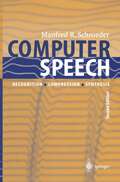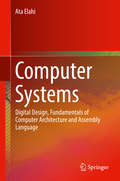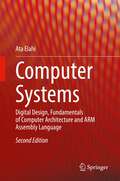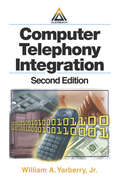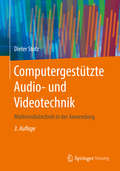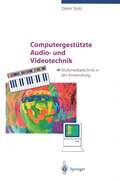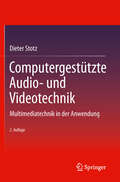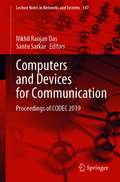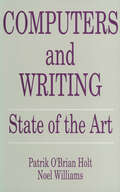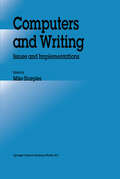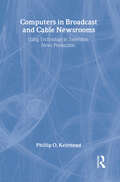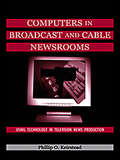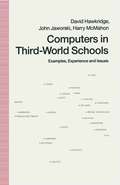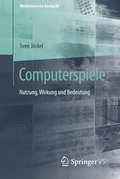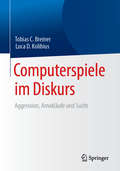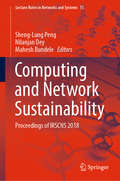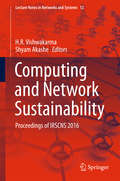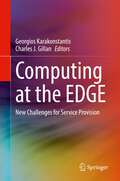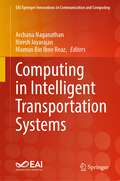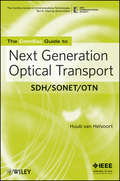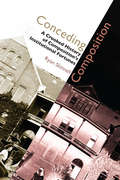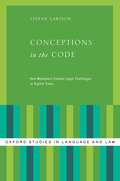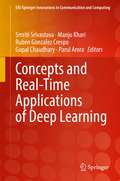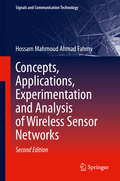- Table View
- List View
Computer Speech: Recognition, Compression, Synthesis (Springer Series in Information Sciences #35)
by Manfred R. SchroederNew material treats such contemporary subjects as automatic speech recognition and speaker verification for banking by computer and privileged (medical, military, diplomatic) information and control access. The book also focuses on speech and audio compression for mobile communication and the Internet. The importance of subjective quality criteria is stressed. The book also contains introductions to human monaural and binaural hearing, and the basic concepts of signal analysis. Beyond speech processing, this revised and extended new edition of Computer Speech gives an overview of natural language technology and presents the nuts and bolts of state-of-the-art speech dialogue systems.
Computer Systems: Digital Design, Fundamentals of Computer Architecture and Assembly Language
by Ata ElahiThis textbook covers digital design, fundamentals of computer architecture, and assembly language. The book starts by introducing basic number systems, character coding, basic knowledge in digital design, and components of a computer. The book goes on to discuss information representation in computing; Boolean algebra and logic gates; sequential logic; input/output; and CPU performance. The author also covers ARM architecture, ARM instructions and ARM assembly language which is used in a variety of devices such as cell phones, digital TV, automobiles, routers, and switches. The book contains a set of laboratory experiments related to digital design using Logisim software; in addition, each chapter features objectives, summaries, key terms, review questions and problems. The book is targeted to students majoring Computer Science, Information System and IT and follows the ACM/IEEE 2013 guidelines. • Comprehensive textbook covering digital design, computer architecture, and ARM architecture and assembly • Covers basic number system and coding, basic knowledge in digital design, and components of a computer • Features laboratory exercises in addition to objectives, summaries, key terms, review questions, and problems in each chapter
Computer Systems: Digital Design, Fundamentals of Computer Architecture and ARM Assembly Language
by Ata ElahiThis updated textbook covers digital design, fundamentals of computer architecture, and ARM assembly language. The book starts by introducing computer abstraction, basic number systems, character coding, basic knowledge in digital design, and components of a computer. The book goes on to discuss information representation in computing, Boolean algebra and logic gates, and sequential logic. The book also presents introduction to computer architecture, Cache mapping methods, and virtual memory. The author also covers ARM architecture, ARM instructions, ARM assembly language using Keil development tools, and bitwise control structure using C and ARM assembly language. The book includes a set of laboratory experiments related to digital design using Logisim software and ARM assembly language programming using Keil development tools. In addition, each chapter features objectives, summaries, key terms, review questions, and problems.
Computer Telephony Integration
by William A. Yarberry Jr.Since the publication of the first edition, the CTI world has changed significantly. Where it was once focused on the integration of voice systems with computers, the focus is now on IP-based voice, or converged networks and services. Today, the telcos are upgrading their systems from circuit-switched to IP-based packet-switched networks. Companies
Computergestützte Audio- und Videotechnik: Multimediatechnik in der Anwendung
by Dieter StotzDiese Einführung in die moderne Audio- und Videotechnik ermöglicht Lesern mit technischem Grundverständnis einen leichten Einstieg – auch in komplexe Zusammenhänge. Der Autor vermittelt detailliertes Wissen, praxisnah und verständlich aufbereitet: von den Grundlagen der Ton- und Videotechnik über Abtastung und Digitalisierung, räumliches Hören, Datenkompression, MIDI-Standard und -Signale, digitale Audiomesstechnik bis zu hochauflösender Videotechnik, Genlock, Chromakeying, Schnittsystemen und Animation. Mit vielen Graphiken und Abbildungen.
Computergestützte Audio- und Videotechnik: Multimediatechnik in der Anwendung
by Dieter StotzLeicht verständlich, klar strukturiert und mit vielen technischen Tips führt das Buch in die Anwendung der ton- und bildverarbeitenden Computersysteme ein.
Computergestützte Audio- und Videotechnik: Multimediatechnik in der Anwendung
by Dieter StotzDiese Einführung in die moderne Audio- und Videotechnik ermöglicht Lesern mit technischem Grundverständnis einen leichten Einstieg – auch in komplexe Zusammenhänge. Der Autor vermittelt detailliertes Wissen, praxisnah und verständlich aufbereitet: von den Grundlagen der Ton- und Videotechnik über Abtastung und Digitalisierung, räumliches Hören, Datenkompression, MIDI-Standard und -Signale, digitale Audiomesstechnik bis zu hochauflösender Videotechnik, Genlock, Chromakeying, Schnittsystemen und Animation. Mit vielen Graphiken und Abbildungen.
Computers and Devices for Communication: Proceedings of CODEC 2019 (Lecture Notes in Networks and Systems #147)
by Nikhil Ranjan Das Santu SarkarThis book gathers selected research papers presented at the 7th International Conference on Computers and Devices for Communication (CODEC 2019), held at the Department of Radio Physics and Electronic, University of Calcutta, India, on 19 – 20 December 2019. It includes recent research in the field of nanomaterials, devices and circuits; microwave and light wave technology; communication and space science; and computer applications and control.
Computers and Writing: State of the Art
by Patrik O'Brian Holt Noel WilliamsPatrik O'Brian Holt Heriot-Watt University After speech, writing is the most common form of human communication and represents the cornerstone of our ability to preserve and record information. Writing, by its very definition, requires artifacts in the form of tools to write with and a medium to write on. Through history these artifacts have ranged from sticks and clay tablets, feather and leather, crude pens and paper, sophisticated pens and paper, typewriters and paper; and electronic devices with or without paper. The development of writing tools has straightforward objectives, to make writing easier and more effective and assist in distributing written communication fast and efficiently. Both the crudest and most sophisticated forms of writing tools act as mediators of human written communication for the purpose of producing, distributing and conserving written language. In the modern world the computer is arguably the most sophisticated form of mediation, the implications of which are not yet fully understood. The use of computers (a writing artifact which mediates communication) for the production and editing of text is almost as old as computers themselves. Early computers involved the use of crude text editors and a writer had to insert commands resembling a programming language to format and print a document. For example to underline a word the writer had to do the following, This is an example of how to .ul underline a single word. in order to produce: This is an example of how to underline a single word.
Computers and Writing: Issues and Implementations
by MikeSharplesThis book grew out of the Fourth Conference on Computers and the Writing Process, held at the University of Sussex in March 1991. The conference brought together a wide variety of people interested in most aspects of computers and the writing process including, computers and writing education, computer supported fiction, computers and technical writing, evaluation of computer-based writing, and hypertext. Fifteen papers were selected from the twenty-five delivered at the conference. The authors were asked to develop them into articles, incorporating any insights they had gained from their conference presentations. This book offers a survey of the wide area of Computers and Writing, and describes current work in the design and use of computer-based tools for writing. University of Sussex M.S. October, 1991 Note from Publisher This collection of articles is being published simultaneously as a special issue, Volume 21(1-3), of Instructional Science - An International Journal of Learning and Cognition. Instructional Science 21: 1-4 (1992) 1 © Kluwer Academic Publishers, Dordrecht Introduction MIKE SHARPLES School of Cognitive and Computing Sciences, University of Sussex, Falmer, Brighton BNl 9QH, United Kingdom.
Computers in Broadcast and Cable Newsrooms: Using Technology in Television News Production
by Phillip O. KeirsteadComputers in Broadcast and Cable Newsrooms: Using Technology in Television News Production takes readers through the use of computers and software in the broadcast/cable newsroom environment. Author Phillip O. Keirstead began writing about television news technology decades ago in an effort to help television news managers cope with technological change. In this text, he demonstrates the myriad ways in which today's journalism is tied to technology, and he shows how television news journalists rely on varied and complex technologies to produce timely, interesting, and informative broadcasts. Using a hands-on, practical approach to cover the role computers play in various parts of the newsroom, the volume will be of great practical value to undergraduate and graduate students in advanced broadcast/news television courses.
Computers in Broadcast and Cable Newsrooms: Using Technology in Television News Production
by Phillip O. KeirsteadComputers in Broadcast and Cable Newsrooms: Using Technology in Television News Production takes readers through the use of computers and software in the broadcast/cable newsroom environment. Author Phillip O. Keirstead began writing about television news technology decades ago in an effort to help television news managers cope with technological change. In this text, he demonstrates the myriad ways in which today's journalism is tied to technology, and he shows how television news journalists rely on varied and complex technologies to produce timely, interesting, and informative broadcasts. Using a hands-on, practical approach to cover the role computers play in various parts of the newsroom, the volume will be of great practical value to undergraduate and graduate students in advanced broadcast/news television courses.
Computers in Third-World Schools: Examples, Experience and Issues
by David Hawkridge John Jaworski Harry McMahonThe reasons why governments of developing countries should put computer technology in their schools are highly controversial, but no less than the actual use being made of these comparatively expensive machines and their software. This book looks at experience in African, Asian and Arabic-speaking countries that already have computers in some of their schools. It is based mainly on research in China, Jordan, Kenya, Mauritius, Sri Lanka and Tunisia. The authors debate policy and practice in the light of experience to date. They identify the rationales commonly deployed by Ministries of Education and international agencies, but argue themselves for a long-term view of the potential of computers to liberalise education, and through such education to reduce dependency and inequity.
Computerspiele: Nutzung, Wirkung und Bedeutung (Medienwissen kompakt)
by Sven JöckelDieser Band gibt einen Überblick darüber, wie Computerspiele sich zu einem populären Massenmedium entwickeln konnten und welche Mythen über ihre individuellen und gesellschaftlichen Nutzungsweisen und Wirkungen tatsächlich von der Forschung belegt werden können (und welche nicht). Von PacMan, Space Invaders über Super Mario, Tomb Raider bis hin zu den Blockbustern Grand Theft Auto und Call of Duty, aber auch zu Candy Crush und Pokemon Go haben sich Computerspiele in den letzten knapp vierzig Jahren zu einem populären und erfolgreichen Unterhaltungsmedium entwickelt. Sie sind dabei, ähnlich wie Filme oder Musik, mittlerweile zum Kulturgut geworden.
Computerspiele im Diskurs: Aggression, Amokläufe und Sucht
by Tobias C. Breiner Luca D. KolibiusDieses Fachbuch ist eine umfassende Abhandlung zur Debatte um die negativen Auswirkungen von Computerspielen: Aggressionen, Amokläufe und Sucht. Die kontroverse Debatte zur Beziehung zwischen Computerspielen und Aggression wird hier auf Grundlage neuster wissenschaftlicher Erkenntnisse aufgearbeitet. Darüber hinaus inspirierte die Aufnahme in die aktuellste Version des Klassifikationssystems DSM für Internet Gaming Disorder (Computerspielsucht) eine Vielzahl wissenschaftlicher Veröffentlichungen, welche hier übersichtlich zusammengetragen werden. In diesem Buch finden Sie die Antworten auf folgende Fragen: Welche Symptome machen eine Computerspielabhängigkeit aus und welche Therapiemöglichkeiten gibt es?Geht Computerspielsucht mit Veränderungen im Gehirn und der Persönlichkeit einher?Gibt es eine kausale Beziehung zwischen Computerspielen einerseits und Aggressivität und Amokläufen andererseits? Die Autoren kommen dabei nach Sichtung der Studienlage zu überraschenden Erkenntnissen. Dieses Buch unterstützt Psychologen, Psychotherapeuten, Psychiater, Pädagogen, Therapeuten, Lehrkräfte und Eltern die Welt der Computerspiele zu navigieren.
Computing and Network Sustainability: Proceedings of IRSCNS 2018 (Lecture Notes in Networks and Systems #75)
by Sheng-Lung Peng Nilanjan Dey Mahesh BundeleThis book offers a compilation of technical papers presented at the International Research Symposium on Computing and Network Sustainability (IRSCNS 2018) held in Goa, India on 30–31st August 2018. It covers areas such as sustainable computing and security, sustainable systems and technologies, sustainable methodologies and applications, sustainable networks applications and solutions, user-centered services and systems and mobile data management. Presenting novel and recent technologies, it is a valuable resource for researchers and industry professionals alike.
Computing and Network Sustainability: Proceedings of IRSCNS 2016 (Lecture Notes in Networks and Systems #12)
by H. R Vishwakarma Shyam AkasheThe book is compilation of technical papers presented at International Research Symposium on Computing and Network Sustainability (IRSCNS 2016) held in Goa, India on 1st and 2nd July 2016. The areas covered in the book are sustainable computing and security, sustainable systems and technologies, sustainable methodologies and applications, sustainable networks applications and solutions, user-centered services and systems and mobile data management. The novel and recent technologies presented in the book are going to be helpful for researchers and industries in their advanced works.
Computing at the EDGE: New Challenges for Service Provision
by Georgios Karakonstantis Charles J. GillanThis book describes solutions to the problems of energy efficiency, resiliency and cyber security in the domain of Edge Computing and reports on early deployments of the technology in commercial settings. This book takes a business focused view, relating the technological outcomes to new business opportunities made possible by the edge paradigm. Drawing on the experience of end user deploying prototype edge technology, the authors discuss applications in financial management, wireless management, and social networks. Coverage includes a chapter on the analysis of total cost of ownership, thereby enabling readers to calculate the efficiency gain for use of the technology in their business.Provides a single-source reference to the state-of-the art of edge computing;Describes how researchers across the world are addressing challenges relating to power efficiency, ease of programming and emerging cyber security threats in this domain;Discusses total cost of ownership for applications in financial management and social networks;Discusses security challenges in wireless management.
Computing in Intelligent Transportation Systems (EAI/Springer Innovations in Communication and Computing)
by Archana Naganathan Niresh Jayarajan Mamun Bin Ibne ReazThis book presents various application areas of computing in the automotive sector. The authors explain how computing enhances the performance of vehicles, covering the applications of computing in smart transportation and the future scope. The authors focus on computing for vehicle safety in conjunction with the latest technologies in Internet of Things (IoT). The book provides a holistic approach to computing in an inter-disciplinary and unified view. Topics covered include driverless automated navigation systems, smart transportation, self-learning systems, in-vehicle intelligent systems, and off-road vehicle diagnosis and maintenance, among others. The authors include simulated examples and case studies for better understanding of the technologies and applications. The book is intended for a wide range of readers from students to researchers and industry practitioners and is a useful resource for those planning to pursue research in the area of computing and autonomous driving vehicles.
The ComSoc Guide to Next Generation Optical Transport: SDH/SONET/OTN (The ComSoc Guides to Communications Technologies #3)
by Huub van HelvoortA comprehensive guide to SDH, SONET, and OTN The ComSoc Guide to Next Generation Optical Transport provides a unique overview of SDH and OTN for engineers who are new to the field, as well as manufacturers, network operators, and graduate students who need a basic understanding of the topics. Fully up-to-date with the latest research and written by one of the foremost experts in the field, it covers: Network architectures Frames and structures Network modeling Packet transport network modeling Frequency justification Protection mechanisms Mapping methodologies Concatenation SDH and SONET overhead processing The book is complemented with 200 illustrations that explain key concepts in an easy-to-understand format, while references point readers to the appropriate standards documents for further reading. Whether you're new to the field or just need a basic understanding of SDH, this is a must-have guide.
Conceding Composition: A Crooked History of Composition's Institutional Fortunes
by Ryan SkinnellFirst-year composition became the most common course in American higher education not because it could “fix” underprepared student writers, but because it has historically served significant institutional interests. That is, it can be “conceded” in multiple ways to help institutions solve political, promotional, and financial problems. Conceding Composition is a wide-ranging historical examination of composition’s evolving institutional value in American higher education over the course of nearly a century. Based on extensive archival research conducted at six American universities and using the specific cases of institutional mission, regional accreditation, and federal funding, this study demonstrates that administrators and faculty have introduced, reformed, maintained, threatened, or eliminated composition as part of negotiations related to nondisciplinary institutional exigencies. Viewing composition from this perspective, author Ryan Skinnell raises new questions about why composition exists in the university, how it exists, and how teachers and scholars might productively reconceive first-year composition in light of its institutional functions. The book considers the rhetorical, political, organizational, institutional, and promotional options conceding composition opened up for institutions of higher education and considers what the first-year course and the discipline might look like with composition’s transience reimagined not as a barrier but as a consummate institutional value.
Conceptions in the Code: How Metaphors Explain Legal Challenges in Digital Times (Oxford Studies in Language and Law)
by Stefan LarssonStefan Larsson's Conceptions in the Code makes a significant contribution to sociolegal analysis, representing a valuable contribution to conceptual metaphor theory. By utilising the case of copyright in a digital context it explains the role that metaphor plays when the law is dealing with technological change, displaying both conceptual path-dependence as well as what is called non-legislative developments in the law. The overall analysis draws from conceptual studies of "property" in intellectual property. By using Karl Renner's account of property, Larsson demonstrates how the property regime of copyright is the projection of an older regime of control onto a new set of digital social relations. Further, through an analysis of the concept of "copy" in copyright as well as the metaphorical battle of defining the BitTorrent site "The Pirate Bay" in the Swedish court case with its founders, Larsson shows the historical and embodied dependence of digital phenomena in law, and thereby how normative aspects of the source concept also stains the target domain. The book also draws from empirical studies on file sharing and historical expressions of the conceptualisation of law, revealing both the cultural bias of both file sharing and law. Also law is thereby shown to be largely depending on metaphors and embodiment to be reified and understood. The contribution is relevant for the conceptual and regulatory struggles of a multitude of contemporary socio-digital phenomena in addition to copyright and file sharing, including big data and the oft-praised "openness" of digital innovation.
Conceptions in the Code: How Metaphors Explain Legal Challenges in Digital Times (Oxford Studies in Language and Law)
by Stefan LarssonStefan Larsson's Conceptions in the Code makes a significant contribution to sociolegal analysis, representing a valuable contribution to conceptual metaphor theory. By utilising the case of copyright in a digital context it explains the role that metaphor plays when the law is dealing with technological change, displaying both conceptual path-dependence as well as what is called non-legislative developments in the law. The overall analysis draws from conceptual studies of "property" in intellectual property. By using Karl Renner's account of property, Larsson demonstrates how the property regime of copyright is the projection of an older regime of control onto a new set of digital social relations. Further, through an analysis of the concept of "copy" in copyright as well as the metaphorical battle of defining the BitTorrent site "The Pirate Bay" in the Swedish court case with its founders, Larsson shows the historical and embodied dependence of digital phenomena in law, and thereby how normative aspects of the source concept also stains the target domain. The book also draws from empirical studies on file sharing and historical expressions of the conceptualisation of law, revealing both the cultural bias of both file sharing and law. Also law is thereby shown to be largely depending on metaphors and embodiment to be reified and understood. The contribution is relevant for the conceptual and regulatory struggles of a multitude of contemporary socio-digital phenomena in addition to copyright and file sharing, including big data and the oft-praised "openness" of digital innovation.
Concepts and Real-Time Applications of Deep Learning (EAI/Springer Innovations in Communication and Computing)
by Smriti Srivastava Manju Khari Ruben Gonzalez Crespo Gopal Chaudhary Parul AroraThis book provides readers with a comprehensive and recent exposition in deep learning and its multidisciplinary applications, with a concentration on advances of deep learning architectures. The book discusses various artificial intelligence (AI) techniques based on deep learning architecture with applications in natural language processing, semantic knowledge, forecasting and many more. The authors shed light on various applications that can benefit from the use of deep learning in pattern recognition, person re-identification in surveillance videos, action recognition in videos, image and video captioning. The book also highlights how deep learning concepts can be interwoven with more modern concepts to yield applications in multidisciplinary fields.Presents a comprehensive look at deep learning and its multidisciplinary applications, concentrating on advances of deep learning architectures;Includes a survey of deep learning problems and solutions, identifying the main open issues, innovations and latest technologies;Shows industrial deep learning in practice with examples/cases, efforts, challenges, and strategic approaches.
Concepts, Applications, Experimentation and Analysis of Wireless Sensor Networks (Signals and Communication Technology)
by Hossam Mahmoud FahmyThe new edition of this popular book has been transformed into a hands-on textbook, focusing on the principles of wireless sensor networks (WSNs), their applications, their protocols and standards, and their analysis and test tools; a meticulous care has been accorded to the definitions and terminology. To make WSNs felt and seen, the adopted technologies as well as their manufacturers are presented in detail. In introductory computer networking books, chapters sequencing follows the bottom up or top down architecture of the seven layers protocol. This book starts some steps later, with chapters ordered based on a topic’s significance to the elaboration of wireless sensor networks (WSNs) concepts and issues. With such a depth, this book is intended for a wide audience, it is meant to be a helper and motivator, for both the senior undergraduates, postgraduates, researchers, and practitioners; concepts and WSNs related applications are laid out, research and practical issues are backed by appropriate literature, and new trends are put under focus. For senior undergraduate students, it familiarizes readers with conceptual foundations, applications, and practical project implementations. For graduate students and researchers, transport layer protocols and cross-layering protocols are presented and testbeds and simulators provide a must follow emphasis on the analysis methods and tools for WSNs. For practitioners, besides applications and deployment, the manufacturers and components of WSNs at several platforms and testbeds are fully explored.
